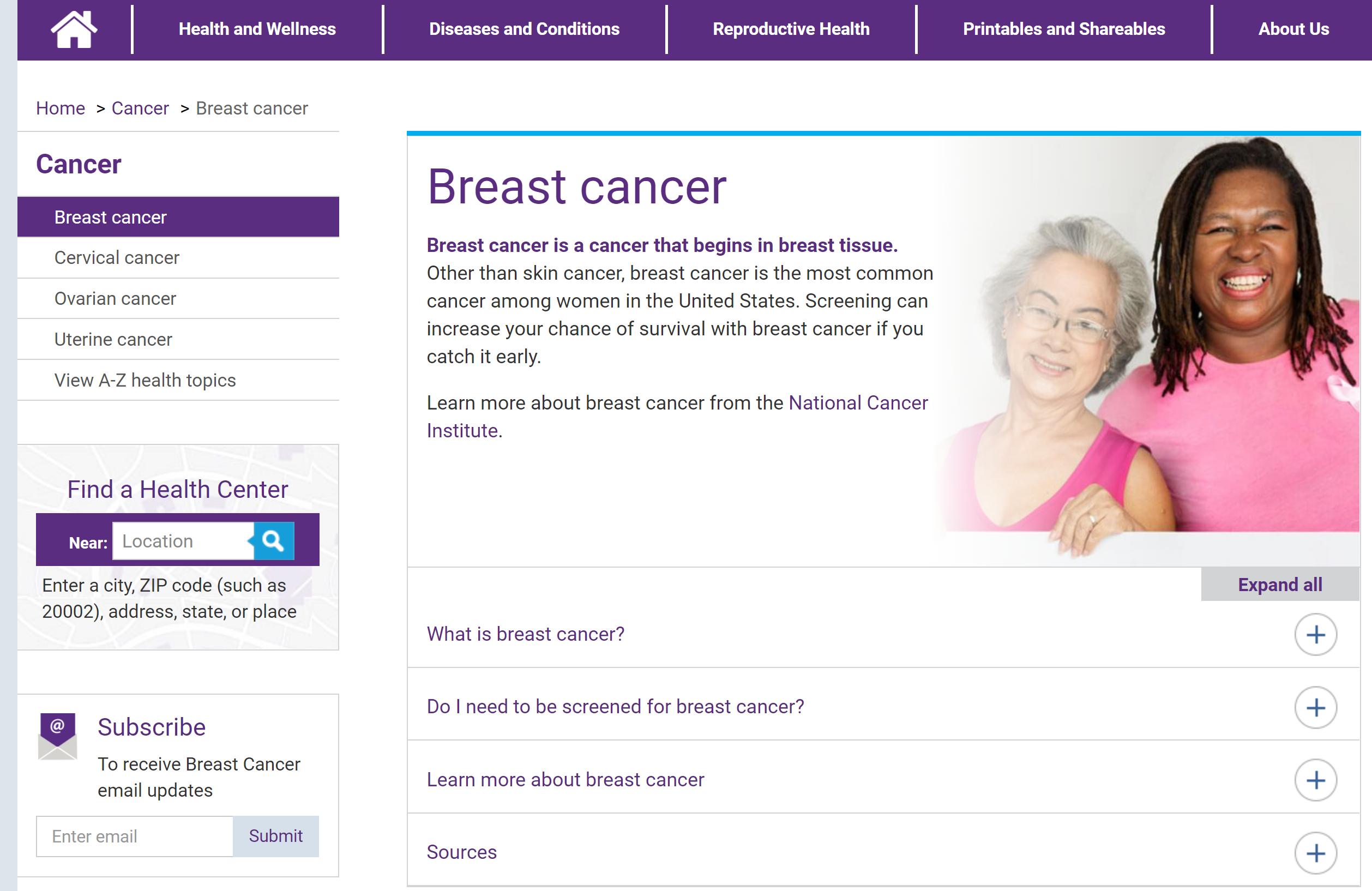Following scrutiny of website removal, HHS women’s health office adds breast cancer page

Screenshot from the new Office on Women’s Health “Breast cancer” page
On April 5, days after the release of our report about the removal of the U.S. Department of Health and Human Services (HHS) Office on Women’s Health (OWH) Breast Cancer website, a single breast cancer page has been added to womenshealth.gov.
The new page contains four brief sections titled: “What is breast cancer?”, “Do I need to be screened for breast cancer?”, “Learn more about breast cancer,” and “Sources.” A link to the National Cancer Institute connects the public to breast cancer information on cancer.gov, a National Institutes of Health website.
The addition of the page followed media inquiries by Politico, ThinkProgress, and other outlets.
HHS did not publicly announce the addition of the new page, nor plans for whether additional breast cancer material will be added to the OWH wesbite, but in answer to our inquiry, a spokesperson for the HHS office shared a statement with the Web Integrity project over email.
OWH told us that the breast cancer pages were removed because they were last updated in 2010 and the information was outdated.
“As I believe you already know, we still have our web pages on mammograms and breast reconstruction after mastectomy,” they wrote. “Also, please note that the best place to learn about breast cancer and all other cancer types is the National Cancer Institute’s website, cancer.gov.”
According to OWH, they are notifying members of the public who are contacting them with concerns about their website that they are in the process of adding breast cancer information to womenshealth.gov.
The spokesperson also told us that HHS OWH complies with all federal record keeping guidelines, noting that “federal record keeping guidelines make no mention of proactively communicating changes to our federal websites to the public.”
OWH provided us with a list of links of NARA guidance, highlighting the “Keep Content Relevant” section.
- HHS Web Records Policy & Guidance
- National Archives Record Management (NARA) Guidance on Managing Web Records
- Checklist of Requirements for Federal Websites and Digital Services
- HHS Web Standards
Section 3506(d)(3) of the Paperwork Reduction Act states, however, that “each agency shall provide adequate notice when initiating, substantially modifying, or terminating significant information dissemination products.”
The “Checklist of Requirements for Federal Websites and Digital Services” page that OWH provided as reference links to both the Paperwork Reduction Act and the White House Office of Management and Budget’s updated Circular A-130, Managing Information as a Strategic Resource, further defines: “‘Information dissemination product’ means any recorded information, regardless of physical form or characteristics, disseminated by an agency, or contractor thereof, to the public.”
Finally, OWH confirmed that the lesbian and bisexual health pages were removed intentionally, with the intention that the their content would be updated and integrated into the health topics pages across WomensHealth.gov.
“This editorial decision is based on data about how website users search for health information online,” wrote the spokesperson.
“Additionally, we recognize that some women identify as lesbian or bisexual, while other women have sex with women but do not identify this way or use these labels. Therefore, to be more inclusive, you can now find information for women who have sex with women or for women in same-sex relationships by searching for relevant health topics on the womenshealth.gov website. For example, on the Chlamydia page (https://www.womenshealth.gov/a-z-topics/chlamydia) the content includes “Can women who have sex with women get chlamydia?”
We’re glad to see that HHS added a page with breast cancer content to WomenHealth.gov, increasing access to information about the disease, but we’re still watching to see how and whether other health info integrated across the site, as claimed.
The OWH lesbian and bisexual health fact sheet, which we reported on two weeks ago in conjunction with Politico, still remains inaccessible. The seven pages of the former breast cancer website, as well as the two fact sheets with breast cancer information linked from those pages, are still not online. Their URLs all now redirect either to the new breast cancer page at the URL https://www.womenshealth.gov/cancer/breast-cancer or the OWH home page. The current redirect status of each page is detailed here.
Among the pages that were removed —and remain offline — are an “Early-stage breast cancer treatment fact sheet,” and resources on “Screening and diagnosis” and “Government in action on breast cancer.
The latter contained information about provisions of the Affordable Care Act that require coverage of no-cost breast cancer screenings for certain women, as well as links to information about a free cancer screening program.
Unfortunately, the lack of proactive narration about the removals from and changes to many agencies’s websites has contributed to misunderstandings about why information was removed, as we described earlier this week, which might undermine the public trust or worsen ongoing fears about censorship.
We hope and expect to see more answers to these questions for the public in the weeks ahead: On April 6, Representative Elijah Cummings, ranking member on the U.S. House Oversight and Government Reform Committee, sent HHS Secretary Alex Azar a letter requesting “information about why the Trump Administration has scrubbed information about breast cancer, preventive services guaranteed by the Affordable Care Act, and various LGBTQ health issues from the Department’s website for the Office of Women’s Health.”
We also hope that what happened at this agency will lead to revised Web governance policies from the National Archives that explicitly include discussion of proactive public engagement and narration of updates, downtime, and removals, which are both important issues given the number and type of changes we’ve seen to federal websites in this administration.

